Materials
The Details on What Makes up My Jewelry
Making sense of metals
As a consumer I like to be informed on what I’m actually buying. I know my customers feel the same way because I get a lot of questions about the different type of materials I use when building my products.
This page explains some of the differences between various metals and should help you make a more informed decision when selecting your ring.
If you’re still curious, I wrote more about this in the blog.

Making sense of metals
As a consumer I like to be informed on what I’m actually buying. I know my customers feel the same way because I get a lot of questions about the different type of materials I use when building my products.
This page explains some of the differences between various metals and should help you make a more informed decision when selecting your ring.
If you’re still curious, I wrote more about this in the blog.
Sterling Silver
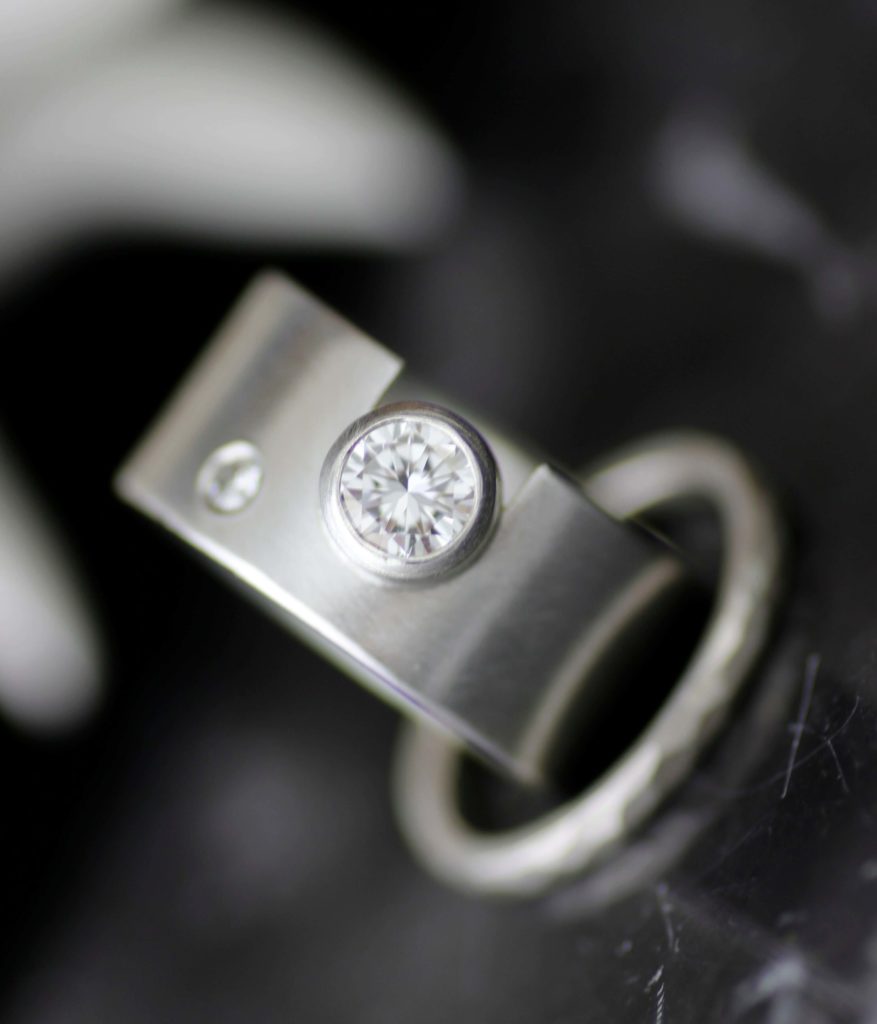
All sterling silver jewelry is .925 silver meaning it is 92.5% pure silver. All sterling silver is 92.5% silver with other metals added to give strength and other characteristics. The silver I most often use is called Sterlium Plus. This is a superior sterling silver alloy that has improved tarnish resistance so maintains a white color longer than regular sterling (much like argentium silver.) However, this alloy is still sterling silver which is the softest and least durable of the precious metals and should not be confused with the harder, more durable metals such as 950 palladium, white gold or platinum. All of those have varying degrees of superior strength, durability and tarnish resistance than silver. Sterling silver does not contain nickel.
Sterling silver it is not recommended for engagement rings and wedding bands. I do continue to offer it as an option for many of my wedding designs for those who may have more cost considerations, but if your budget allows, opt for one of the other white metal alloys if you are purchasing wedding jewelry.
Please note that of all the metal choices, sterling silver is the most reactive, and in some rare cases when silver comes in contact with sulfurous substances, it will turn completely black. In fact this is how jewelers purposefully use oxidization as a decorative element in silver jewelry. This is not an indication of a defect or the fault of the maker. It is a surface reaction only and can be removed by a local professional jeweler or I can do it for you for a fee. However, this does not qualify as a manufacturing defect and is not covered by the warranty. If this is of concern to you, please consider choosing a different metal for your ring.
An alloy of pure gold with other white metals. White gold is a bit of a misnomer as all gold is yellow, and white gold has many variations with varying attributes. White gold is creating by alloying yellow gold with various white metals such as nickel or palladium. “Regular” or “nickel” white is made with nickel which some people may have a reaction to. I also offer palladium white gold which is a nickel-free white gold option. More information on palladium white gold can be found under that tab.
White gold is greyer and darker than silver or platinum. It also has a warmer tone to it. White gold will become more “yellow” as it ages, but is a very hard, durable metal as well, and the different karats refer to purity. 10K is approximately 41% gold, 14K is approximately 58% gold, 18K is approximately 75% gold, and so on. The karats also have a factor in how the metal performs. Therefore, not all karats are offered in all designs.
Please note that most white gold you may see in large jewelry stores is rhodium plated. I do not plate my gold, although my items can be plated locally, if desired.
White Gold
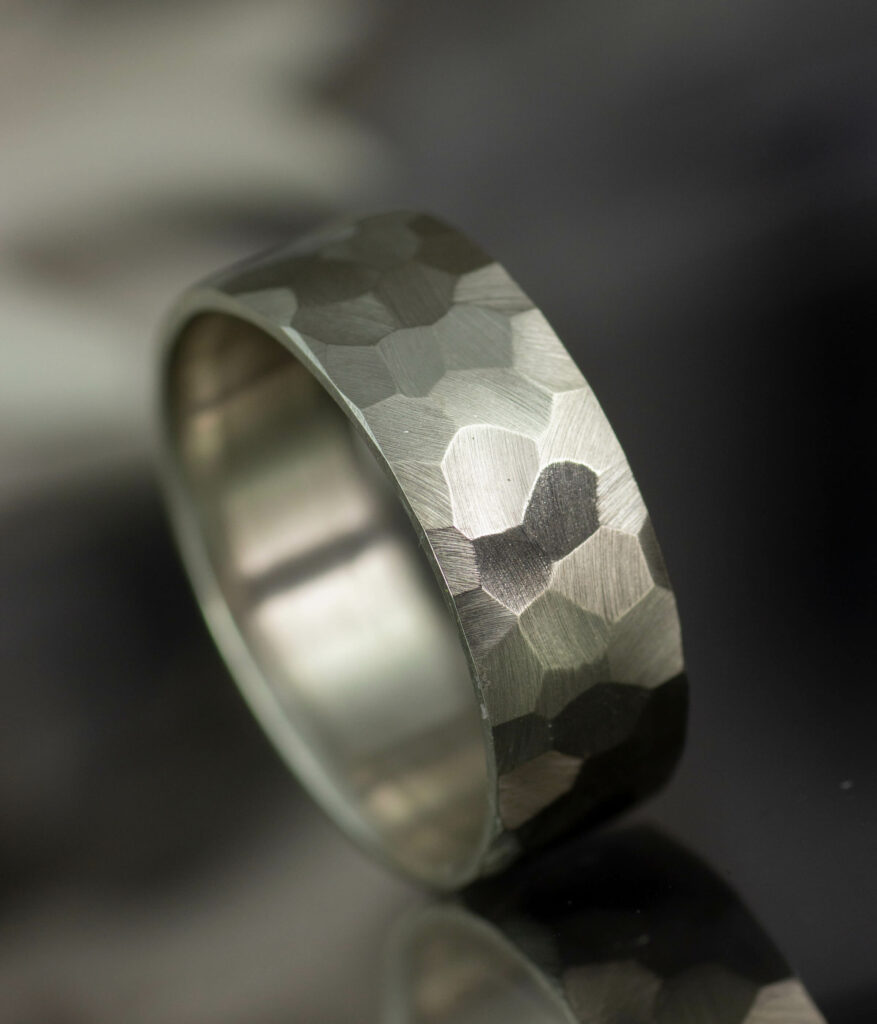
Palladium White Gold
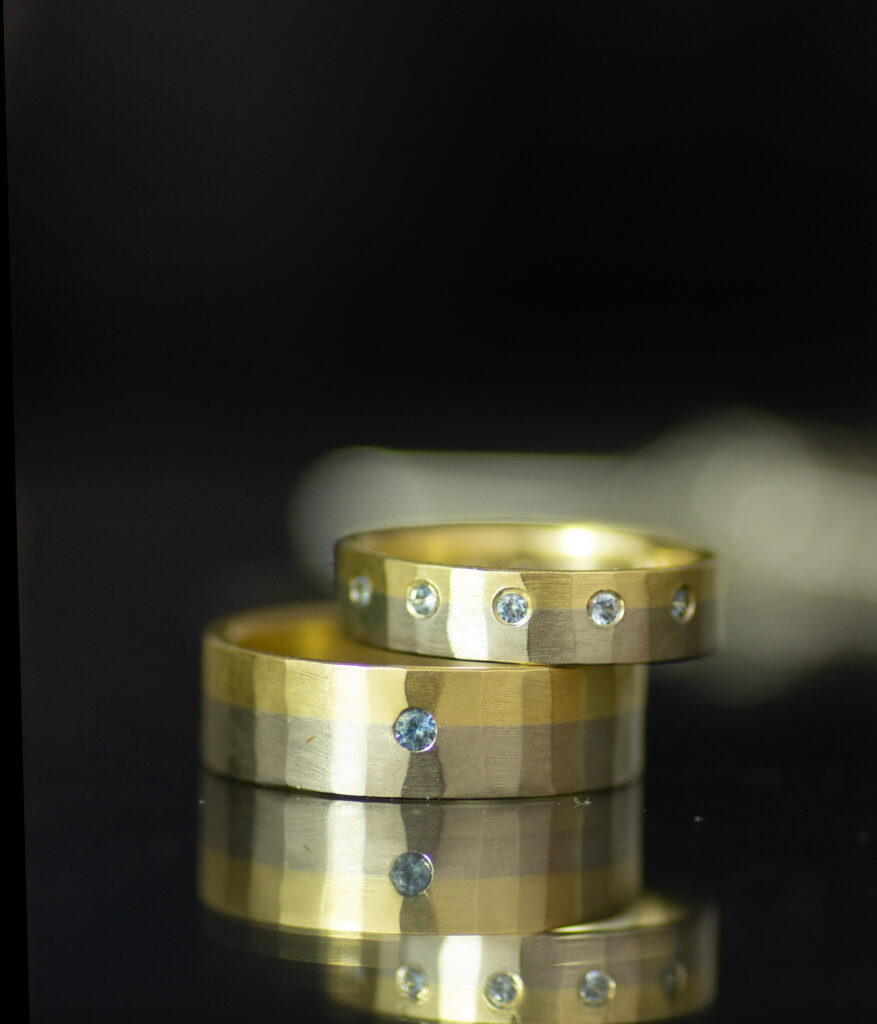
An alloy of gold, palladium and other metals. Palladium white gold is the standard in UK/Europe and Australia as it uses palladium rather than nickel alloyed with the gold to create a “whiter” look. Palladium white gold is less yellow than “nickel” white but warmer than platinum.
Palladium white gold tarnishes much less over time than regular “nickel” white, but is not quite as hard. Palladium white is offered in 18K or 14K as a special order. 18K palladium white gold has a darker grey color similar to that of PD5. It’s a great choice for those who want gold, but have a known nickel allergy, want an alloy that is warmer than platinum, or want a lower maintenance white gold.
Most people are more familiar with these alloys. They mainly differ just in color. Higher karats are a little softer, but also richer and deeper in color, so 18K rose gold or 18K yellow gold has a deeper hue than 14K and 14K more than 10K gold.
Rose gold is also referred to as red or pink gold. For rose gold, copper is usually added to give its characteristic hue
Yellow and Rose Gold
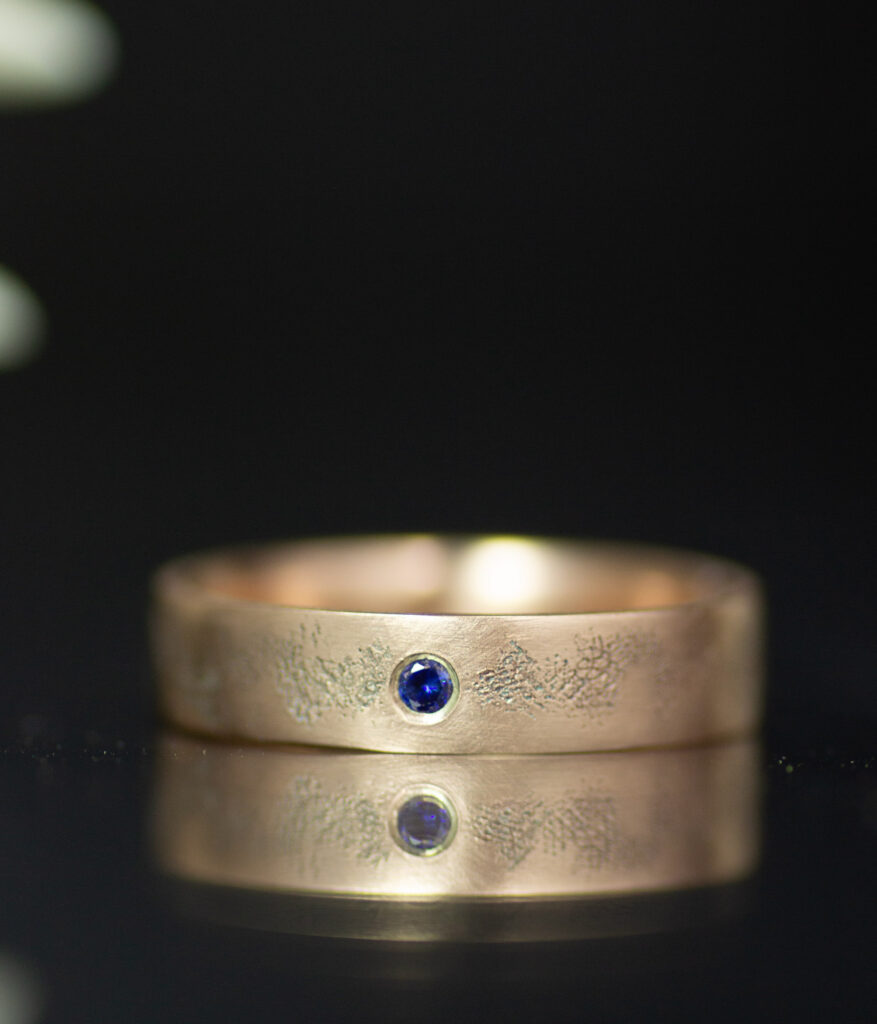
Platinum
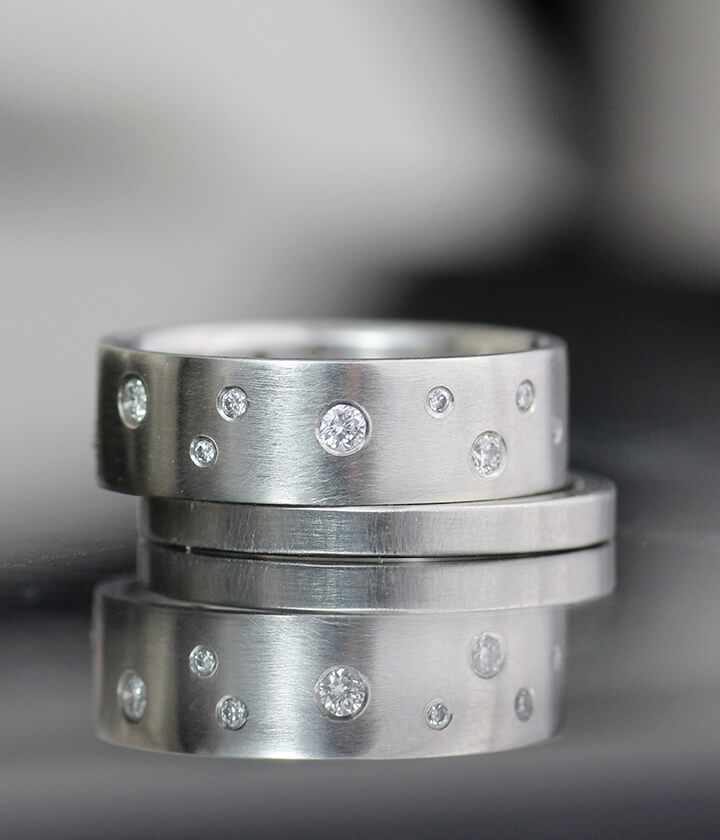
Platinum is considered the most superior in performance of all the precious metals. Platinum is the densest and at one time was the most valuable of the metals. Rhodium plated white gold was created in order to mimic platinum.
Platinum is 95% pure and it has a slightly whiter finish than white gold or palladium. it is hypo-allergenic, very durable and scratch resistant. Platinum does not tarnish and holds up extremely well over time with little maintenance. It’s density is a large part of why it is more expensive as metals are sold by weight and platinum is the densest – thus the heaviest – of all the alloys.
95% palladium is a strong durable metal comparable to white gold. Palladium is greyer and cooler in tone than white gold. It is virtually hypo – allergenic and does not tarnish. Palladium prices have quadrupled in recent years, making it one of the most expensive alloys for jewelry.
Because of these increased costs, major suppliers have stopped carrying the alloy and therefore 950 palladium is no longer available for most designs. I highly recommend platinum as a less expensive and superior alternative or if you prefer the darker grey color, choose 18K palladium white gold.
950 Palladium

PD5
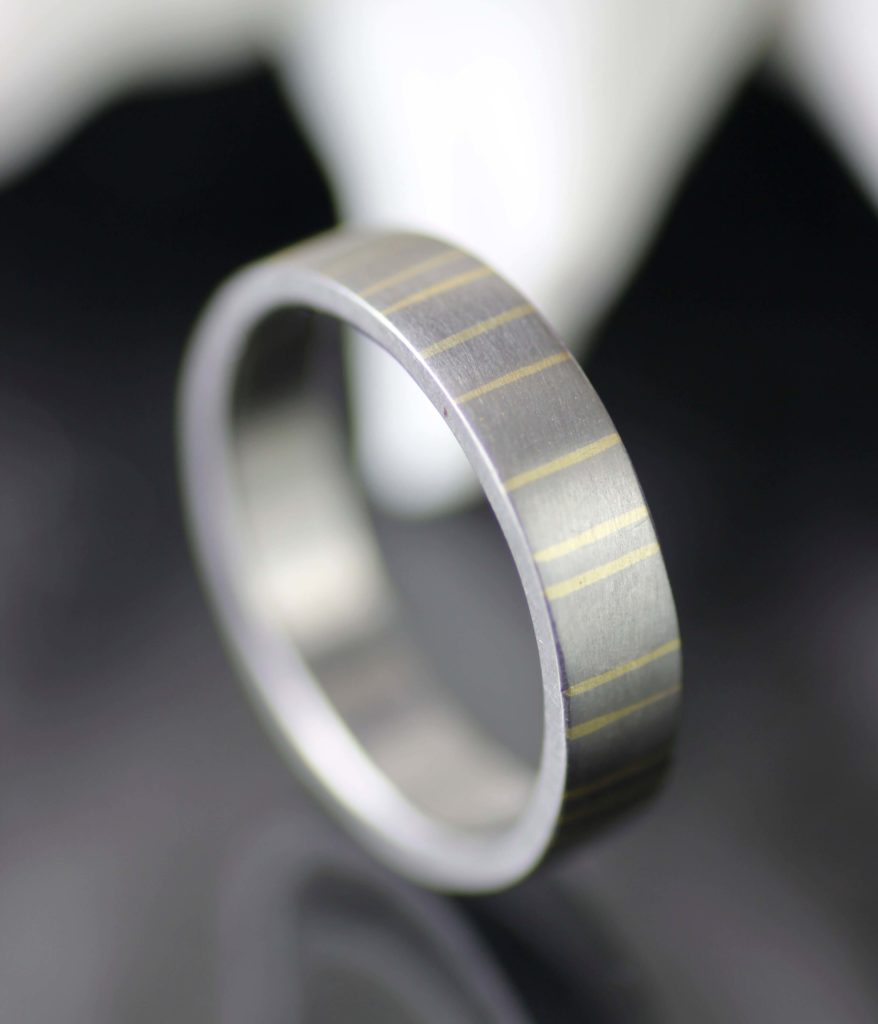
Alloy of approximately 50/50 silver and palladium. PD5 is approximately 50% palladium with most of the rest of the alloy being made up of silver and some other proprietary metals. Somewhat surprisingly, this actually makes the alloy a darker grey. PD5 is the darkest of all the precious metals with a dark neutral grey.
PD5 is not as hard as 950 palladium or white gold but is far superior to sterling silver in strength and does not tarnish. It’s also a great way to add more intense color contrast to mixed metals rings like my fusion or gold stripe rings. The drawback is that PD5 is difficult to resize and most likely cannot be resized locally as most jewelers are not familiar with it.
Sterlium Plus

All sterling silver jewelry is .925 silver meaning it is 92.5% pure silver. All sterling silver is 92.5% silver with other metals added to give strength and other characteristics. The silver I most often use is called Sterlium Plus. This is a superior sterling silver alloy that has improved tarnish resistance so maintains a white color longer than regular sterling (much like argentium silver.) However, this alloy is still sterling silver which is the softest and least durable of the precious metals and should not be confused with the harder, more durable metals such as 950 palladium, white gold or platinum. All of those have varying degrees of superior strength, durability and tarnish resistance than silver. Sterling silver does not contain nickel.
Sterling silver it is not recommended for engagement rings and wedding bands. I do continue to offer it as an option for many of my wedding designs for those who may have more cost considerations, but if your budget allows, opt for one of the other white metal alloys if you are purchasing wedding jewelry.
Please note that of all the metal choices, sterling silver is the most reactive, and in some rare cases when silver comes in contact with sulfurous substances, it will turn completely black. In fact this is how jewelers purposefully use oxidization as a decorative element in silver jewelry. This is not an indication of a defect or the fault of the maker. It is a surface reaction only and can be removed by a local professional jeweler or I can do it for you for a fee. However, this does not qualify as a manufacturing defect and is not covered by the warranty. If this is of concern to you, please consider choosing a different metal for your ring.
White Gold

An alloy of pure gold with other white metals. White gold is a bit of a misnomer as all gold is yellow, and white gold has many variations with varying attributes. White gold is creating by alloying yellow gold with various white metals such as nickel or palladium. “Regular” or “nickel” white is made with nickel which some people may have a reaction to. I also offer palladium white gold which is a nickel-free white gold option. More information on palladium white gold can be found under that tab.
White gold is greyer and darker than silver or platinum. It also has a warmer tone to it. White gold will become more “yellow” as it ages, but is a very hard, durable metal as well, and the different karats refer to purity. 10K is approximately 41% gold, 14K is approximately 58% gold, 18K is approximately 75% gold, and so on. The karats also have a factor in how the metal performs. Therefore, not all karats are offered in all designs.
Please note that most white gold you may see in large jewelry stores is rhodium plated. I do not plate my gold, although my items can be plated locally, if desired.
Palladium White Gold

An alloy of gold, palladium and other metals. Palladium white gold is the standard in UK/Europe and Australia as it uses palladium rather than nickel alloyed with the gold to create a “whiter” look. Palladium white gold is less yellow than “nickel” white but warmer than platinum.
Palladium white gold tarnishes much less over time than regular “nickel” white, but is not quite as hard. Palladium white is offered in 18K or 14K as a special order. 18K palladium white gold has a darker grey color similar to that of PD5. It’s a great choice for those who want gold, but have a known nickel allergy, want an alloy that is warmer than platinum, or want a lower maintenance white gold.
Yellow & Rose Gold

Most people are more familiar with these alloys. They mainly differ just in color. Higher karats are a little softer, but also richer and deeper in color, so 18K rose gold or 18K yellow gold has a deeper hue than 14K and 14K more than 10K gold.
Rose gold is also referred to as red or pink gold. For rose gold, copper is usually added to give its characteristic hue.
Platinum

Platinum is considered the most superior in performance of all the precious metals. Platinum is the densest and at one time was the most valuable of the metals. Rhodium plated white gold was created in order to mimic platinum.
Platinum is 95% pure and it has a slightly whiter finish than white gold or palladium. it is hypo-allergenic, very durable and scratch resistant. Platinum does not tarnish and holds up extremely well over time with little maintenance. It’s density is a large part of why it is more expensive as metals are sold by weight and platinum is the densest – thus the heaviest – of all the alloys.
950 Palladium

95% palladium is a strong durable metal comparable to white gold. Palladium is greyer and cooler in tone than white gold. It is virtually hypo – allergenic and does not tarnish. Palladium prices have quadrupled in recent years, making it one of the most expensive alloys for jewelry.
Because of these increased costs, major suppliers have stopped carrying the alloy and therefore 950 palladium is no longer available for most designs. I highly recommend platinum as a less expensive and superior alternative or if you prefer the darker grey color, choose 18K palladium white gold.
PD5

Alloy of approximately 50/50 silver and palladium. PD5 is approximately 50% palladium with most of the rest of the alloy being made up of silver and some other proprietary metals. Somewhat surprisingly, this actually makes the alloy a darker grey. PD5 is the darkest of all the precious metals with a dark neutral grey.
PD5 is not as hard as 950 palladium or white gold but is far superior to sterling silver in strength and does not tarnish. It’s also a great way to add more intense color contrast to mixed metals rings like my fusion or gold stripe rings. The drawback is that PD5 is difficult to resize and most likely cannot be resized locally as most jewelers are not familiar with it.